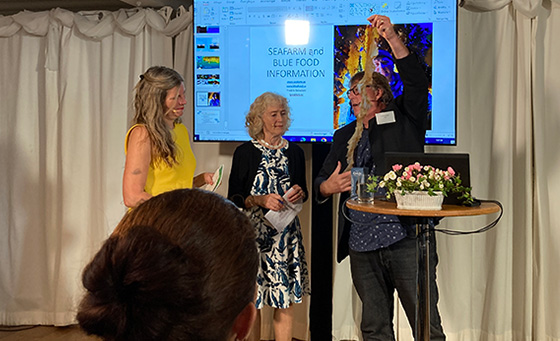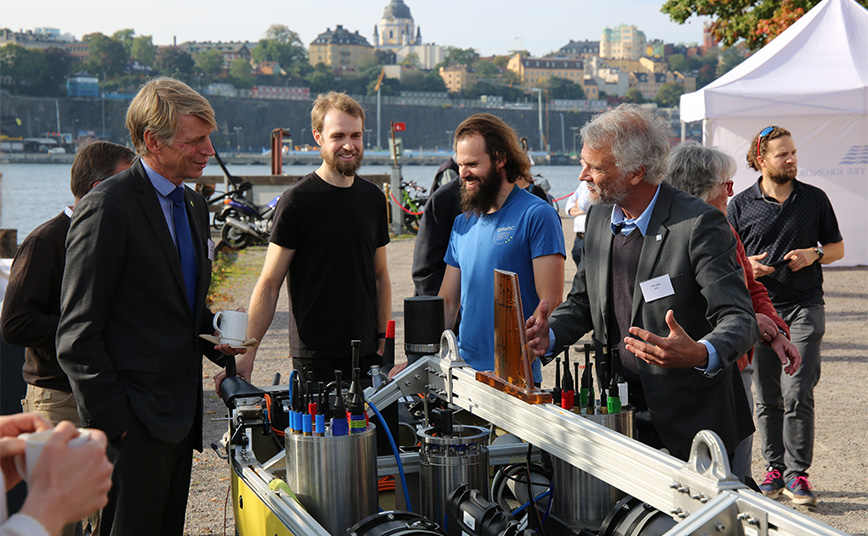KTH researchers on robots, sailboats, seaweed, and släke in the Baltic Sea Seminar

Several research projects and areas of research at KTH share a common theme: water. Visitors to this year's Baltic Sea Seminar at Kolskjulet, titled 'A Blue Economy Requires the Well-being of the Baltic Sea' heard about robots, modern sailboats, algae cultivation, and släke – beach-cast macroalgae – as a new-old fertilizer. This was the tenth time the seminar was held, and for the first time, KTH was one of the organizers.
Since 2011, the Baltic Sea Seminar at Kolskjulet has provided researchers' insights into the future of topics such as eutrophication, environmental toxins, fishing, and biodiversity. In late September 2023, KTH was involved in organizing the seminar for the first time.
Marine Hunting Dogs, Cost-effective Knowledge Gatherers

In the seminar's first part, Peter Sigray from KTH's Maritime Robotics Laboratory talked about robotization. He compared assisted intelligence to a horse pulling a carriage and autonomous intelligence – represented today by a swarm of drones – to a group of hunting dogs working together.
Peter Sigray described types of robots and concepts that can be used to promote a green transition – underwater robots, surface drones, cooperative drones, autonomous sailing, bottom landers, and buoys. They can be used, for example, to increase knowledge about changing temperatures and salinity affecting algae and other marine life. The robots can also indicate whether the Baltic Sea is sequestering or producing carbon and how the balance changes as the sea evolves. Measurements that are expensive and difficult with other technology become easier with robots capable of manoeuvring in hard-to-reach areas. They can map and monitor changes in underwater vegetation. Compared to other methods, it is cost-effective and requires less personnel. In short, robots make it easier to obtain the right data.
KTH Aims to Teach the World to Sail Again

During the 20th century, we forgot how to sail, and we need to relearn it. At least according to Jakob Kuttenkeuler, at KTH's centre for naval architecture. He wants to equip the world's merchant fleet with sails, on a larger scale.
Today, there are approximately 100,000 commercial cargo ships, which account for 90% of the world's trade volume. One larger ship can consume 40 tons of oil per day. KTH researchers aim to change that with the help of 40-meter-tall sails that have more in common with airplane wings than traditional fabric sails. The concept of replacing fossil power with wind power was developed in Oceanbird, a collaboration between academia and industry. KTH's contribution involves mechanics and technology, from idea to model and simulation to testing and measurements, in a delicate interplay between hydrodynamics and aerodynamics, that is, what happens below the surface and in the air. Students have also been involved and have built a model used for testing. If all goes according to plan, the first sail could be installed on an existing cargo ship as early as 2024, and a few years later, we may hopefully witness the first fully modern sailboat. And it could have a significant impact. The work so far shows that emissions can be reduced by up to 90%.
Food and Energy from the Sea's Forests

According to Fredrik Gröndahl, at KTH's Water and Environmental Engineering, we have reached the capacity limit for what we can obtain from land, while losing species and worsening the climate. When the forest is not enough to transition from fossil to a bio-based society, the sea's forests – algae – can become a significant part of the solution.
In 2014, the Seafarm project, led by KTH, started on the Swedish west coast. It has shown that it is possible to cultivate fast-growing algae in Swedish waters, and they have a wide range of uses: food, ingredients in beer and gin, materials for items like toothbrushes, and even to inhibit methane emissions from cattle. The first cultivation was on two hectares, and Sweden has room for much more, if we collaborate wisely. One way to extract more from the sea sustainably is to establish algae farms and other aquaculture near wind farms. This not only provides more efficient use of the sea's surface but can also contribute to greater acceptance of the wind power industry by creating local jobs. Collaborations have been initiated with several energy companies. Another collaboration involves robots developed at Smarc, a center for marine robots where KTH researchers are developing and training the Sam robot to monitor algae farms. Fredrik Gröndahl is also the director of the Blue Food Center, which brings together 70 companies and organizations. So, what about the Baltic Sea? Unfortunately, it has too low salinity for many algae, but projects have been initiated to cultivate Ulva algae that could potentially thrive there as well.
Släke, from resource to problem to resource again

Släke, beach-cast macroalgae, has been a sought-after resource for centuries to provide fields with nutrients. When mineral fertilizers became popular, släke went from being a resource to waste, but its beneficial properties remain. Släke can still contribute nutrients, carbon, and water-retaining properties. Hanna Nathaniel, a doctoral student at KTH, has spent the past five years researching how släke can regain relevance.
When it lies on the beach, släke releases nutrients over a very long time. If we instead compost and use it in agriculture, we can harness the nutrients through crops, and ideally, increase carbon storage and reduce nutrient leakage. However, it is complicated because, while it is economically viable to use släke as a eutrophication remedy, it doesn't have a clear place in today's agriculture, where its beneficial properties lack economic value, and the alternative is mineral fertilizer. One of Hanna Nathaniel's conclusions is that subsidies and non-profit organizations are crucial, and that resources that give back to nature are unfortunately undervalued.
This year's Baltic Sea Seminar at Kolskjulet was organized by Stockholm University Baltic Sea Centre, KTH, and Expedition Baltic Sea.
Read more about the seminar and watch parts of it (in Swedish)
Kungahuset: Kronprinsessan närvarade vid Östersjöseminarium
